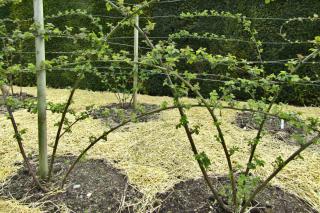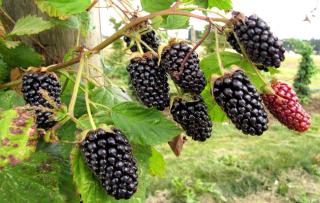

Blackberry shrubs offer delicious blackberries if you care for them well.
Basic blackberry facts
Name – Rubus fruticosus
Family – Rosaceae
Type – fruit shrub
Height – 3 to 10 feet (1 to 3 m)
Exposure – full sun, part sun
Soil – rich enough
Foliage – deciduous
Flowering – summer
Harvest – end of summer
Planting, pruning, and care, here are the practices to grow a bountiful blackberry harvest.
You can refer this question to your local horticulture store, where experts on what grows in your area will recommend the best varieties of blackberry bushes without any thorns.
It is planted preferably in fall, but also until spring as long as it doesn’t freeze.
It is highly recommended to attach the blackberry shrubs. Either simply follow a straight line with stakes, or try the following innovation:
 Purchase T-shape fencing stakes 8 feet (2.5 m) long, set them along two rows 6 feet (2 meters) apart, with intervals of one to two yards (one to two meters). Drill holes through their center at 1 foot intervals (30 cm).
Purchase T-shape fencing stakes 8 feet (2.5 m) long, set them along two rows 6 feet (2 meters) apart, with intervals of one to two yards (one to two meters). Drill holes through their center at 1 foot intervals (30 cm).Pruning is in fall or winter, cutting down to ground level any branch that has born blackberries, while safeguarding all the year’s new growth.
>> Video tips on training and pruning a black bush <<
New growth is what will bear fruit in the following year.
You must be patient: the blackberry bush you’ve planted this year will only bear fruit next year, but the harvest will quickly increase as years go by.
The diligent gardener that lurks within will thus give his blackberry bush loving care and attention, and all will be repaid with delicious fruits, jams and jellies.
For an abundant harvest, select more productive cultivars such as ‘Apache’, ‘Dirksen’, ‘Smoothstern’ or ‘Darrow’.
The most tasty blackberries are often the ones you’ll find in the wild. They tend to be more tangy and flavorful. Their drawbacks? Size! And all those THORNS!

Who hasn’t yet noticed those blackberry briar patches along countryside roads, which from August onwards attract knowledgeable cooks and gourmets alike?
Some of us even keep secrets handed down from one generation to the next about where the most luscious and bountiful berry spots are, to go there discreetly and harvest enough to prepare blackberry jam and blackberry jelly!
The best time to harvest blackberries in the wild depends on where you live (climate zones). But it usually spans two-three weeks sometime in August or September. It depends whether they’re early or late varieties.
Grow blackberries to make your very own jams, pies, crumbles and blackberry juice: satisfaction guaranteed!